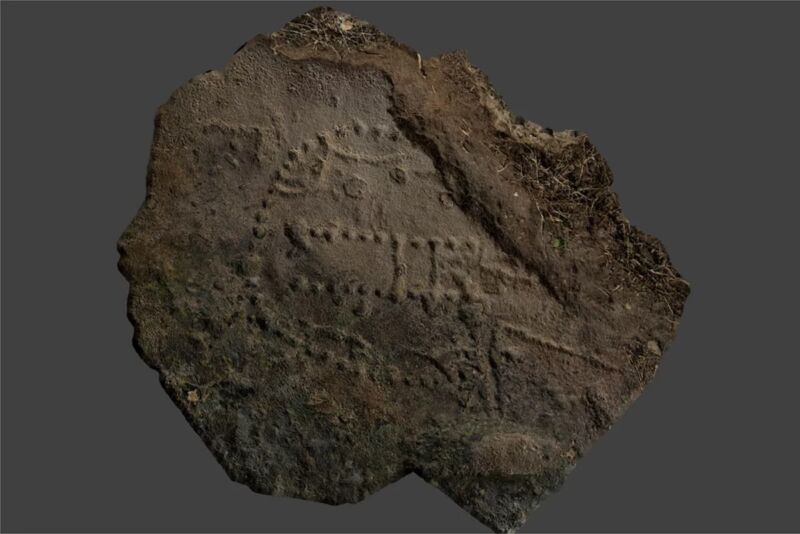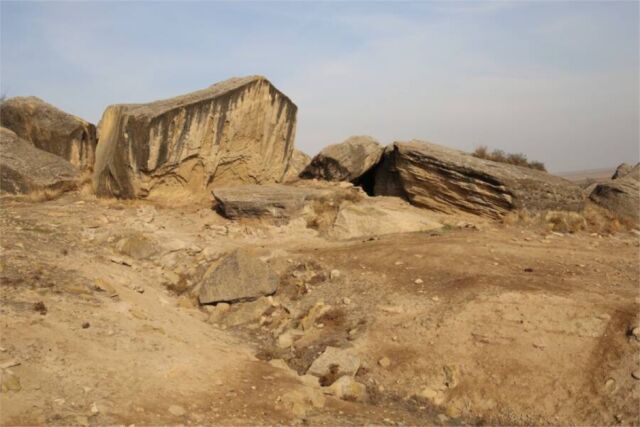
W. Crist et al., 2024
An ancient board game known as Hounds and Jackals has long been believed to have originated in Egypt. However, according to a paper published in the European Journal of Archaeology, a version of the game board found in present-day Azerbaijan might date back even earlier, suggesting that the game originated in Asia.
As previously reported, there is archaeological evidence for various kinds of board games from all over the world dating back millennia: Senet and Mehen in ancient Egypt, for example, or a strategy game called ludus latrunculorum (“game of mercenaries”) favored by Roman legions. A 4,000-year-old board discovered last year at an archaeological site in Oman’s Qumayrah Valley might be a precursor to an ancient Middle Eastern game known as the Royal Game of Ur (or the Game of Twenty Squares), a two-player game that may have been one of the precursors to backgammon (or was replaced in popularity by backgammon). Like backgammon, it’s essentially a race game in which players compete to see who can move all their pieces along the board before their opponent.
Last year, archaeologists discovered a 500-year-old game board in the ruins of Ćmielów Castle in Poland. It was a two-person strategy board game called Mill, also known as Nine Men’s Morris, Merels, or “cowboy checkers” in North America. The earliest-known Mill game board was found carved into the roofing slabs of an Egyptian temple at Kurna, which likely predates the Common Era. Historians believe it was well-known to the Romans, who may have learned of the game through trade routes.
Similar boards have also been found carved into cloister seats at English cathedrals. A game board was found in a 13th-century church in Opole, Poland, and depictions of people playing the game were inscribed on 15th-century stove tiles in Wielkopolska. One explanation is that construction workers, while building the castle, carved the game board into a slab of the sandstone floor as a diversion for their leisure time. It’s also possible the board could have been carved by children or by servants after the castle was completed, or it may have been meant as a symbolic message.
Fifty-Eight Holes

European Journal of Archaeology
This latest find is a game board of Hounds and Jackals, aka Fifty-Eight Holes, commonly played in ancient Egypt. Known to modern scholars since 1890, some 60 examples of the game have been unearthed in Egypt, Mesopotamia, Israel, Syria, Iran, and Azerbaijan. The board has two parallel sets of 29 holes, and players use 10 small sticks with either jackal or dog heads, similar to the board and pegs of cribbage. It’s probably a two-person “race game” were the aim was to move all one’s pegs from the starting point on the board to the end point—the hole at the top of the board, which is larger than all the others.
The oldest version of Hounds and Jackals discovered before now dates back to 2064–1952 BCE during the reign of Mentuhotep II, suggesting that the game originated in Egypt. The game board featured in this study was discovered in 2018 by archaeologist and co-author Walter Crist in Gobustan, Azerbaijan. He examined several rock shelters carved with dot patterns that closely resembled game boards found in southwestern Asia and Egypt; the best of those was found at the Çapmalı rock shelter near the Western shore of the Caspian Sea.
Crist and his co-author, Rahman Abdullayev, concluded the carving was associated with the Middle Age Bronze layer at the site. This suggests that people played the game long before it appeared in Egypt. Six other examples of Hounds and Jackals game boards have been found at sites in Ağdaşdüzü, Yeni Türkan, and Dübəndi. Pottery shards discovered at the sites suggest that shepherds sheltering in the area during winter regularly played the game to pass the time.
The authors caution that it can be complicated to achieve precise dating for this period. “Clearly, further early evidence for the game from precisely dated contexts is required to credit a specific culture for inventing the game,” they wrote. Regardless of the game’s origin, “it was quickly adopted by a wide variety of people…. The fast spread of this game attests to the ability of games to act as social lubricants, facilitating interactions across social boundaries.”
European Journal of Archaeology, 2024. DOI: 10.1017/eaa.2024.24 (About DOIs).




















+ There are no comments
Add yours